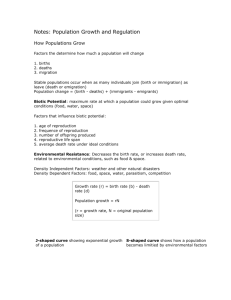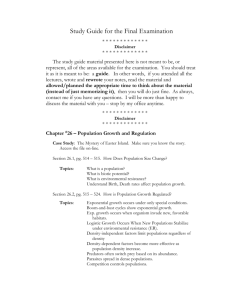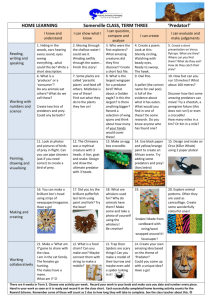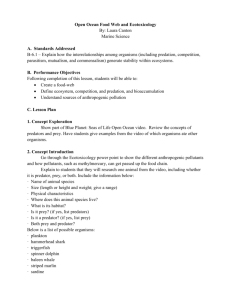reading and questions: population growth
advertisement
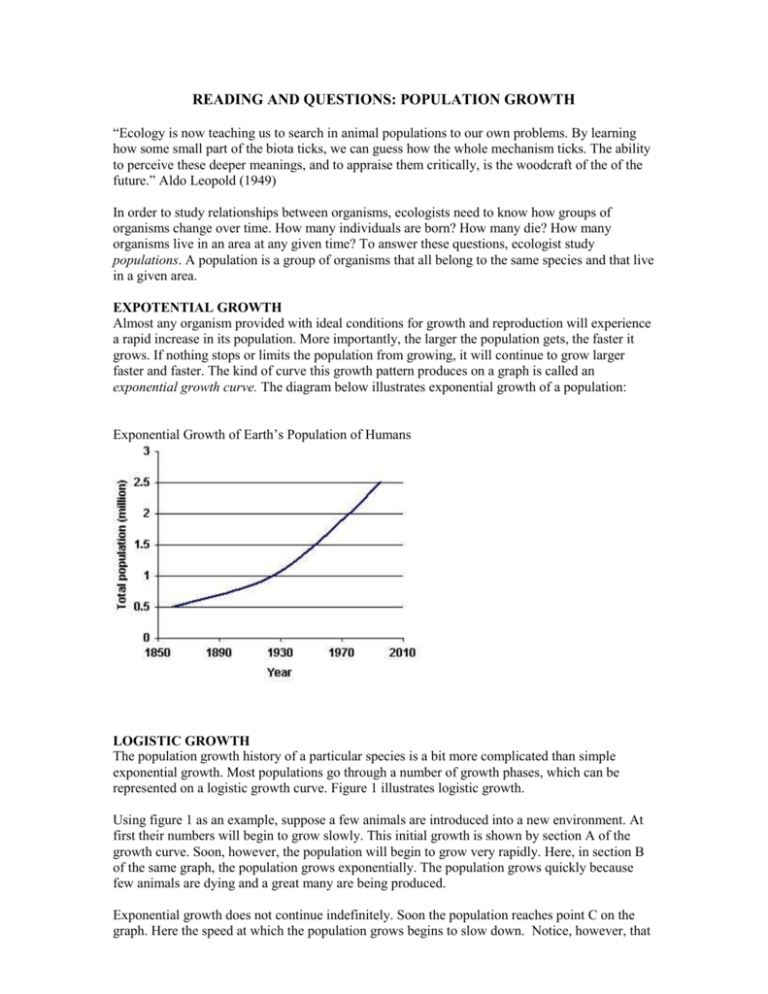
READING AND QUESTIONS: POPULATION GROWTH “Ecology is now teaching us to search in animal populations to our own problems. By learning how some small part of the biota ticks, we can guess how the whole mechanism ticks. The ability to perceive these deeper meanings, and to appraise them critically, is the woodcraft of the of the future.” Aldo Leopold (1949) In order to study relationships between organisms, ecologists need to know how groups of organisms change over time. How many individuals are born? How many die? How many organisms live in an area at any given time? To answer these questions, ecologist study populations. A population is a group of organisms that all belong to the same species and that live in a given area. EXPOTENTIAL GROWTH Almost any organism provided with ideal conditions for growth and reproduction will experience a rapid increase in its population. More importantly, the larger the population gets, the faster it grows. If nothing stops or limits the population from growing, it will continue to grow larger faster and faster. The kind of curve this growth pattern produces on a graph is called an exponential growth curve. The diagram below illustrates exponential growth of a population: Exponential Growth of Earth’s Population of Humans LOGISTIC GROWTH The population growth history of a particular species is a bit more complicated than simple exponential growth. Most populations go through a number of growth phases, which can be represented on a logistic growth curve. Figure 1 illustrates logistic growth. Using figure 1 as an example, suppose a few animals are introduced into a new environment. At first their numbers will begin to grow slowly. This initial growth is shown by section A of the growth curve. Soon, however, the population will begin to grow very rapidly. Here, in section B of the same graph, the population grows exponentially. The population grows quickly because few animals are dying and a great many are being produced. Exponential growth does not continue indefinitely. Soon the population reaches point C on the graph. Here the speed at which the population grows begins to slow down. Notice, however, that the size of the population does not drop. The population is still growing, but it is growing at a slower rate. From here on, the population grows more and more slowly, through section D on the curve. A population grows when more organisms are produced in a given period of time than die during the same period. In this situation, and ecologist would say that the population’s birth rate is greater than its death rate. Population growth may slow down because either the birth rate decreases or because the death rate increases or both. When the birth rate and death rate are the same, population growth will stop, or reach zero growth. Remember, a population growth rate of zero means that the number of organisms in the population remains the same. Look at the section of logistic growth curve labeled E, which is called steady state. During the steady state, the average growth rate is zero. However, it is important to note that the steady state is not really all that steady. The population rises and falls somewhat. In fact, in some populations it rises and falls a great deal. But the rises and falls average out around a certain population size. The horizontal line drawn through the middle of the steady state region shows how large the population is in the steady state. Ecologists say this line represents the carrying capacity of a particular environment for a particular species. Once a population reaches the carrying capacity of its environment, certain factors keep the population from growing any farther. These factors include a lack of food, overcrowding and competition among individuals (intraspecific competition) in the population. If the population does not grow larger, either the birth rate will fall or the death rate will rise. In other words, more individuals will die than will be born and the population will be reduced to the carrying capacity. If the population falls, the birth rate will rise or the death rate will drop; so more individuals will be born than will die and the population will grow once again until carrying capacity is reached. LIMITING FACTORS TO POPULATION GROWTH Why is it that populations do not grow indefinitely? Populations can be controlled by several factors. A lack of food, water, space or some other basic necessity acts as a limiting factor for every population. Other factors that limit growth include competition, predation and parasitism. A limiting factor is any component of a natural system environment that halts further growth in a population. The maximum size of a population that can be supported by the environment is called carrying capacity. Although controls on natural populations do not keep those populations from changing size, no single species has ever threatened to overpopulate the entire planet. (That is, not until Homo sapiens came along.) Intraspecific and Interspecific Competition When populations become crowded, organisms compete, or struggle, with one another for food, water, space, sunlight and other essentials for life. It is easy to see that competition among members of the species- intraspecific competition- is a limiting factor. Members of a particular population occupy the same niche. The more individuals there are, the more of them there are to use up the available food, water, space and other necessities. The fewer individuals around, the less they compete with each other. Competition between members of different species – interspecific competition- is a major force behind evolutionary change. No two organisms can occupy the same niche in the same place at the same time. When two different species compete, both find themselves under pressure from natural selection to change in ways that decrease their competition. This idea is important because it ties ecology and evolution together. It is another example of the way in which all the biological sciences are interrelated when you look at them from an evolutionary point of view. Predation Just about every species serves as food for some other species. In most situations, predators and prey coexist over long periods of time. When you watch populations of predators and prey over time, you almost always find changes in their numbers. Typically, at some point the prey population grows so large that pray are numerous and easy to find. With such a large and available food supply to feed upon, there may soon be almost as many predators as prey. This situation, however, cannot last because each predator needs many prey to satisfy its energy needs. As predators become numerous, they eat more prey than are born. This means that they prey’s death rate becomes higher than its birth rate and the population decreases in size. But as the prey population drops, predators begin to starve, so the predator population drops too. When only a few predators are left, the prey begins reproducing and surviving in large numbers again, and the whole situation repeats itself. For many years people did not realize that the predator-prey relationship are important in controlling natural populations. Travelers and farmers took animals from one part of the world to another, releasing them into the wild. There without a natural predator to keep their numbers down, the animals become serious pests. This has become a serious problem in the rivers of the Edwards Aquifer in Central Texas because people have dumped their aquaria into rivers when they are tired of keeping aquatic pets. Ram shorn snails were introduced into the San Marcos River in this way. Ram shorn snails do not have a natural predator, as they do in their native Australia; hence, their population is growing unchecked. They are consuming the aquatic plants that native animals need for food and shelter at an alarming. One plant, Texas wild rice, is facing extinction. Currently there is no solution to the over population of these snails in our native Texas Rivers. Parasitism Parasites act like predators in many ways. They live off their hosts, weakening them and causing disease. Like predators, parasites work most effectively if hosts are present in large numbers. Crowding helps parasites travel from one host to another. Stress related to crowding can reduce a host’s resistance to parasites. As a result parasitism often affects large, concentrated populations more than small, scattered ones. Note that few parasites kill their hosts-at least not right away. If a parasite kills its host too quickly, the parasite will have no chance to reproduce and spread. It is thus to the parasite’s advantage not to be too deadly. Crowding and Stress Most animals have a built-in behavioral need for a certain amount of space. Both males and females, for example, may need room to hunt for food. They may need a certain amount of space for nesting. Or they may need a territory of a certain size. Certain species fight among themselves if they are overcrowded. Too much fighting can cause high levels of stress. This stress disturbs the finely tuned endocrine system (the body system composed of glands that secrete hormones, or chemical messengers, into the bloodstream). As a result of hormonal changes, animals may fight more and breed less. Hormonal changes can so upset a female’s behavior that she neglects, kills or even eats her own offspring. Extreme overcrowding can also cause hormonal changes that cause a pregnant female to miscarry. Often the immune system (the body system that fights disease) is weakened as well. All these factors combine to lower birth rate. Disease Some individuals within a population may be more susceptible to a disease. These individuals may die or become weakened due to the disease, thus increasing the death rate. In some cases, disease may cause the extinction of an entire population. Natural Catastrophe Some populations can be greatly reduced by fire, flood, drought or unseasonable cold weather. These types of natural occurrences can nearly wipe out a population. Such population reductions are not a result of population density. Questions: All questions should be answered on a separate sheet of paper using complete sentences. 1. Explain how the evolution of a successful defense mechanism in a prey species might increase the chances of survival for a predator species that uses the prey for food? 2. Define carrying capacity. 3. Explain why it is often unwise to introduce new species to an established ecosystem. 4. In what ways can crowding and stress affect the heath of a population? 5. Explain how exponential growth and logistic growth differ. 6. List limiting factors for any population. 7. Define zero growth in a population.


